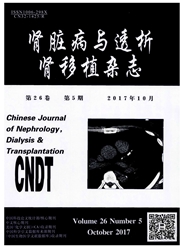

 中文摘要:
中文摘要:
目的:探讨尿液microRNA-196a(miR-196a)能否作为预测局灶节段性肾小球硬化(FSGS)远期预后的生物标志物。方法:收集FSGS患者和正常对照的尿液和血浆标本,分析尿液和血浆miR-196a水平与FSGS活动性的关系。入选231例经肾活检确诊的FSGS,qRT-PCR方法检测尿液miR-196a水平,评估尿液miR-196a对FSGS预后的预测价值。结果:尿液miR-196a水平在活动性FSGS患者组显著高于肾脏疾病完全缓解组和正常对照组(P〈0.001),血浆miR-196a水平在三组之间无明显差异,表明尿液miR-196a是一种主要来源于肾脏的生物标志物。231例随访患者中,43例进展为终末期肾病(ESRD)。发生ESRD的患者尿液miR-196a水平显著高于未发生ESRD的患者(P=0.025)。尿液miR-196a水平与蛋白尿和估算的肾小球滤过率(e GFR)相关,与肾间质纤维化评分存在相关性。随着尿液miR-196a水平增加,患者发生ESRD的风险增加。校正年龄、性别、蛋白尿、e GFR后尿液miR-196a升高仍是患者进展至ESRD的独立危险因素。结论:尿液miR-196a是FSGS患者发生ESRD的独立危险因素,可能成为预测FSGS远期预后的新型生物标志物。
 英文摘要:
英文摘要:
Objective: To investigate the association between urinary microRNA-196a( miR-196a) and long-term outcome in patients with focal segmental glomerulosclerosis( FSGS). Methodology: Urinary and plasma miR-196 a were tested in patients with active FSGS( FSGS-A),FSGS in complete remission( FSGS-CR) and normal controls( NC). 231 FSGS patients were then enrolled at the time of renal biopsy and urinary miR-196 a levels were measured by qRT-PCR. The relationship between urinary miR-196 a and long-term outcome of FSGS was analyzed. Results: Urinary miR-196 a levels were significantly increased in FSGS-A patients as compared with FSGS-CR patients and NCs( P〈0. 001). However,plasma miR-196 a levels showed no difference among the three groups,suggesting that the change of urinary miR-196 a was mainly kidney derived. Of the 231 patients,43 patients developed end-stage renal disease( ESRD) during the follow-up period. Urinary miR-196 a levels were significantly higher in patients who progressed to ESRD than those not progressed to ESRD( P = 0. 025). Urinary miR-196 a was associated with proteinuria,e GFR,and interstitial fibrosis. Patients with higher urinary miR-196 a levels had a higher cumulative incidence of ESRD. Risk persisted after adjusting for age, sex,proteinuria,and eG FR. Conclusion: Urinary miR-196 a is an independent risk factor of ESRD, facilitating early identification of those who will subsequently develop ESRD.
 同期刊论文项目
同期刊论文项目
 同项目期刊论文
同项目期刊论文
 期刊信息
期刊信息
